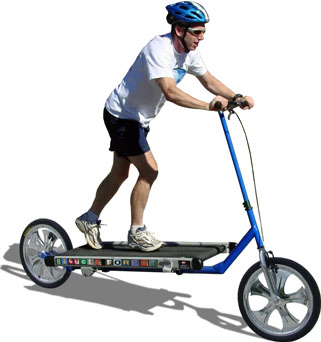In Hertzian Tales: Electronic Products, Aesthetic Experience, and Critical Design (pdf), Anthony Dunn introduces the concept of “para-functionality” in consumer objects. These objects are designed such a way that their use makes us reflect on how the electronic products condition our behavior. They are usable but “go beyond functionalism to include the poetic.” In the realms of health and healthcare innovation, we can often find para-functional objects in odd places.
The Treadmill Bike
It’s just like it sounds, a treadmill connected to a bicycle frame. Instead of sitting and pedaling as you would do on a normal bike, the treadmill bike let’s users run on a treadmill outdoors and steer with handlebars.

The makers of the Treadmill Bike, the Bicycle Forest, experiment with building different bike types mostly for fun. The website boasts:
When the weather’s nice, the last place you want to be is cooped up in some stuffy gym. Imagine running through evergreen forests or strolling down country roads. All of this is possible thanks to the rugged design and all terrain tires on the revolutionary Treadmill Bike.
The bike is perfectly functional. Running on the treadmill propels the runner (cyclist?) ahead and he would get the same workout as he would on a treadmill on the gym. Yet if this is the solution for taking your treadmill running outside and even possibly running errands, why not do what our grandparents did and actually pound some pavement. This is where the para-functions of the Treadmill Bike’s design come in.
First there was jogging, popularized in the 60s as a form of sociable fitness. Then treadmills entered homes as a way to go for a run when you can’t or don’t want to jog outside. Now, Bicycle Forest, took this one step further, taking the treadmill itself back outside for a jog. It’s sort of ridiculous and a nod to how the treadmill has changed our jogging behavior. It’s also a commentary on our dependence of a gym or gym equipment to do exercise.
There is something poetic about jogging in place but still be in motion at the same time.
Website: http://www.bikeforest.com/tread/index.php
Video: http://youtu.be/reyt3uiQqI8
JumpSnap, Virtual Jump Rope
 Jumping rope is a great cardiovascular workout. It’s used in the training of all sorts of atheletes. It’s a great way to build up heat in your body as a warm up or as a main component to burning calories and building stamina. The JumpSnap product is dubbed a “virtual jump rope.” It has a computer, sensors, and displays giving you stats on your jumping. What the virtual jump rope actually doesn’t have is the rope itself. A jump rope without a rope sounds like a gimmick. But with the extra computing power, this becomes another example of para-functional design.
Jumping rope is a great cardiovascular workout. It’s used in the training of all sorts of atheletes. It’s a great way to build up heat in your body as a warm up or as a main component to burning calories and building stamina. The JumpSnap product is dubbed a “virtual jump rope.” It has a computer, sensors, and displays giving you stats on your jumping. What the virtual jump rope actually doesn’t have is the rope itself. A jump rope without a rope sounds like a gimmick. But with the extra computing power, this becomes another example of para-functional design.
The JumpSnap allows its users to jump rope without the rope, essentially shortcutting the hand-feet and timing coordination needed to accomplish jumping rope. By cutting out the skills needed, JumpSnap is effectively making it easier to “train like a pro without the rope tripping you up.” The JumpSnap makes a snapping sound as you spin it to keep you in rhythm. It counts the jumps and calories burned, and uses audio voice to speak to the user.
The addition of these electronic components make up for the lack of the rope. It also begs the question whether we need a rope at all to “jump rope,” another example of how electronic products can condition our behavior. If you can achieve the same workout by doing the movements, then a rope is not needed. The JumpSnap is challenging the core meaning and activity behind a jumping rope workout. The video ad even claims that you don’t have to jump at all. Simply bending at the knees will engender similar results without impact on the body. This essentially means that JumpSnap is promoting a product with which you can “jump rope” without a rope and without jumping. So with enough motivation, you can probably “JumpSnap” without a JumpSnap too.
Website and video: https://www.jumpsnap.com/
The Concrete Chair

Outside of the fitness category, this piece is more of an artistic statement. “The Concrete Chair” by Stefan Zwicky takes Le Corbusier’s “LC2 armchair” and transforms it into a monolithic piece of furniture which expresses the weight and cold nature of concrete. We use concrete most commonly for building structures, streets and sidewalks. The best chair, arguably, is one that is comfortable to sit on and easy on the body. By presenting a concrete chair, Zwicky is marrying these two concepts and creating a poetic reflection on the function of chairs: sitting comfortably on the street and sidewalk.
Although this is not an electronic product, the Concrete Chair asks us to reflect on our conditioned behavior of sitting in chairs. We’ve evolved chair design to make sitting better on the body. However there is a growing evidence that shows how sitting for hours at a time has a negative effect on one’s health. There is movement of people building awareness of the stress effects of sitting on the body. Some go as far as to conclude that sitting can kill you.
Sitting on the Concrete Chair is probably not any more desirable than sitting on a concrete floor. Perhaps the reflection here is maybe standing is just fine.
The Concrete Chair: http://www.stefanzwicky.ch/
Sitting Can Kill You Infographic: http://www.buzzfeed.com/
Get Up. Get Out. Don’t Sit (NYTimes – 10/17/12): http://well.blogs.nytimes.com/